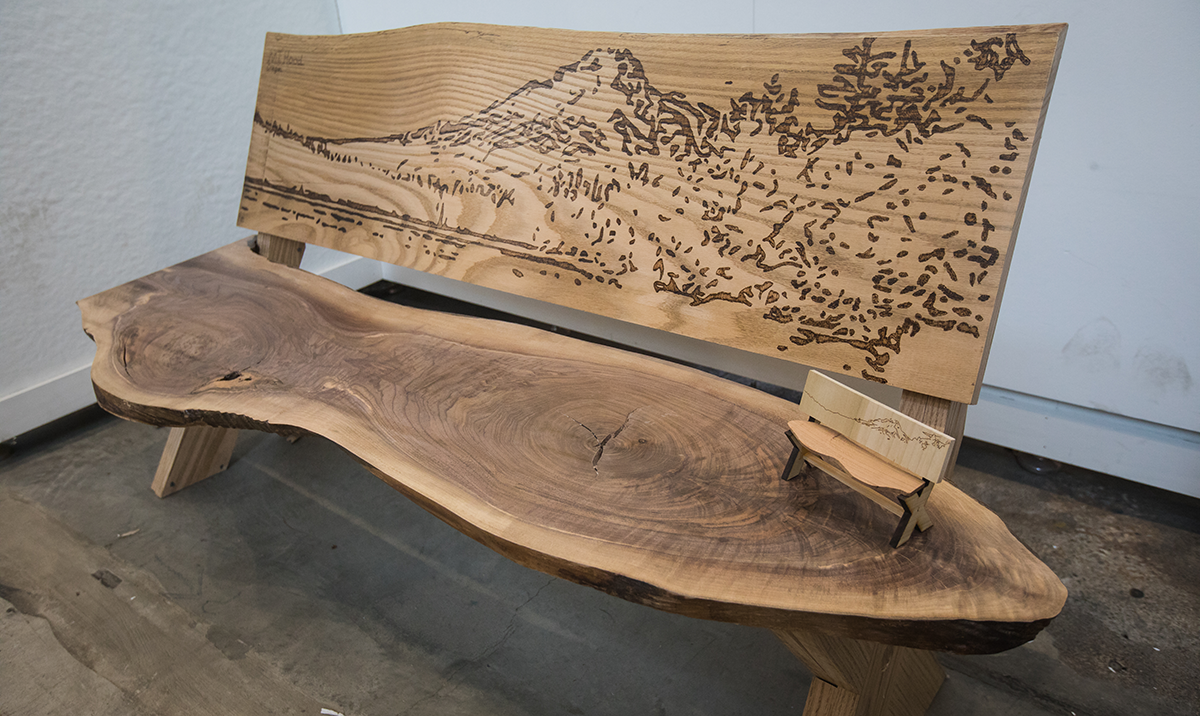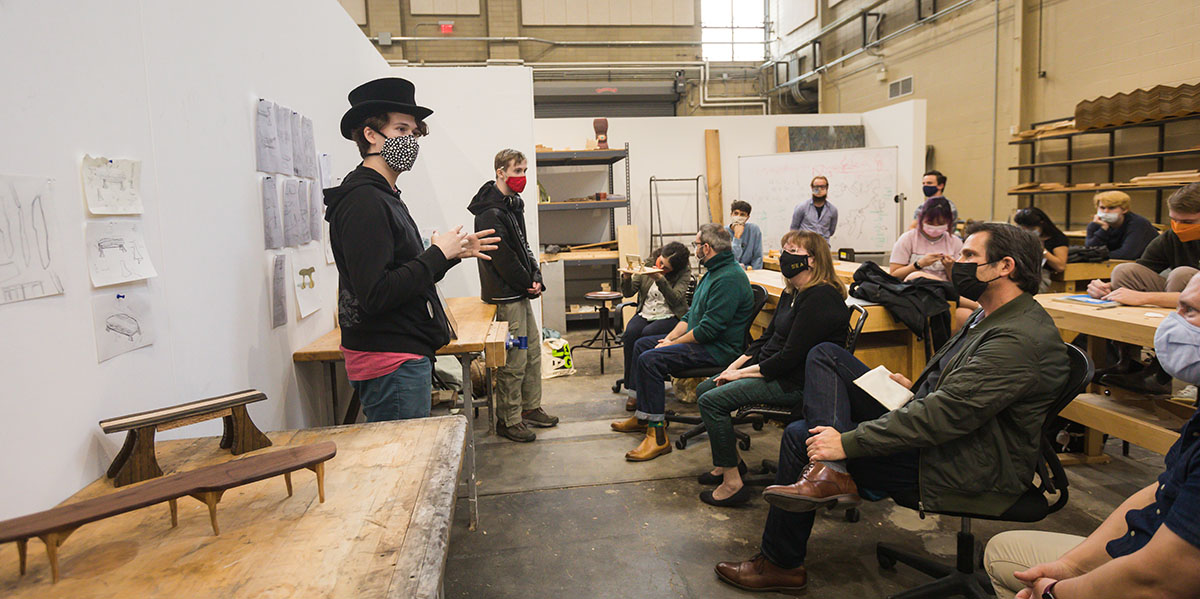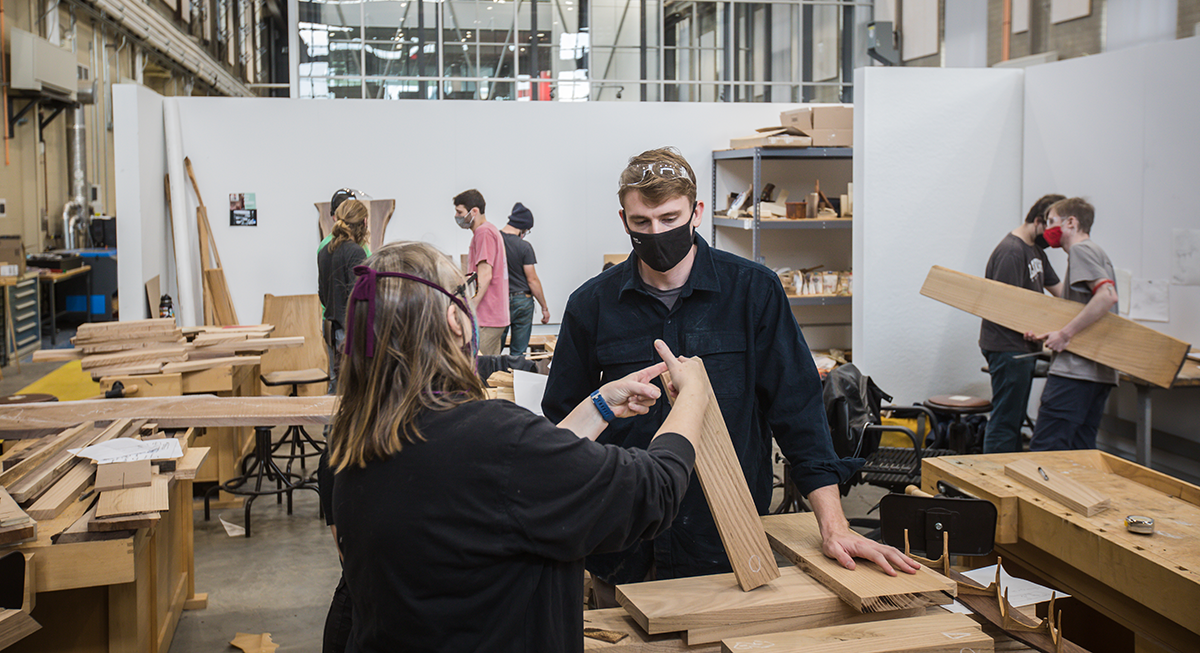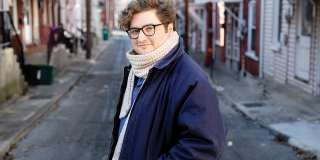
What could have been consumed in a fireplace was turned into beautiful bench seating for community use in art galleries by students in Professor Amy Forsyth’s Fall 2021 semester Furniture Design course. The white oak and black walnut wood — estimated at being between 150- and 175-years-old — was donated by Heather Rodale ’74 ’76G ’05P who envisioned its potential after the trees were removed for an expansion of Healing Through the Arts, a non-profit organization that she founded in 2009. A member of the Lehigh University Art Galleries (LUAG) Director’s Advisory Council, Rodale initiated the project idea with William Crow, LUAG director and professor of practice in the department of art, architecture, and design (AAD).
“Heather is a wonderful advocate for art and also the well-being that experiences with art can provide, and she initiated this project by discussing how important it is — for all visitors — to have comfortable seating when enjoying the art galleries,” said Crow, who added that Rodale is a visionary supporter of the arts not only at LUAG but in the programs Healing Through the Arts offers that incorporate art to aid in a person’s healing process.
Open to undergraduates in any major, the Furniture Design AAD course traditionally has students create a piece of furniture for their final project that they get to keep. But in the fall class, the seven custom-designed indoor benches were earmarked for galleries and other community arts organizations including LUAG, the Allentown Art Museum, and the Baum School of Art.
“A lot of the time hands-on projects are taught to show students how to learn something specific, but this assignment is a complete circle because it also teaches them about philanthropy,” said Forsyth, an associate professor of design who has been working in wood for 25 years. “It teaches students how important it is to use their skills for the benefit of other people.”
The Process of Making a Lasting Contribution
Rodale had three large trees professionally milled and cured for seven years prior to the start of the project. The planks were delivered to Lehigh’s Mountaintop Campus and housed next to the wood shop in Building C.
Rodale had three large trees professionally milled and cured for seven years prior to the start of the project. The planks were delivered to Lehigh’s Mountaintop Campus and housed next to the wood shop in Building C.
The students started the semester by learning carving skills using gouges and chisels to create a mask made from bass wood. Forsyth then taught a series of joinery techniques including half lap joints, mortise and tenons, hand-cut dovetails, and box joints that are crucial to wood joinery and, ultimately, bench stability.
“There are times when improvisation is appropriate and times when it's not. The time when it is not is when you're making joinery that's going to have to support hundreds of pounds of people using hundreds of pounds of wood,” said Forsyth, who has bachelor’s and master’s degrees in architecture and also teaches three-dimensional design foundations, sketching, and a class on making experimental musical instruments.
Students worked in pairs, with one trio group, and brainstormed ideas and drew sketches. They toured the campus art galleries and discussed bench use and placement. Forsyth created a Pinterest page with seating examples for inspiration.

“I'd say, ‘That's a really cool idea, but there's no way you're going to be able to make it in three to four weeks.’ So, we kept simplifying and simplifying,” said Forsyth. “One project was actually more complex than I thought they could handle, but the students were really dedicated and did a really nice job with it.”
Quarter-scale models were created out of the oak and walnut and made to look as close to the outcome as possible. Students presented their prototypes for critique to Rodale; Crow; Stacie Brennan ’03, LUAG curator of education; Mark Wonsidler, LUAG curator, exhibitions and collections; and Max Weintraub, president and CEO, Allentown Art Museum.
“During the collaboration, we gave the students insight into creating the benches for safety and use by both children and adults in need of a rest within the galleries. I found the students' creativity inspiring, and it was a joy to watch the project unfold,” said Rodale, who will receive a bench for the Healing Through the Arts building in Allentown. “These benches will enable us to rest, reflect, and restore our spirit within the beauty of museum galleries.”
With no pre-requisite class required to take the course, the students’ experience ranged from beginner to practiced. Depending on their background or major, they brought different talents or skillsets to their projects such as design ability or understanding construction. Experienced in automotive design, Samuel Goff ’23, design major, brainstormed ideas with teammates Michael Hoben ’22, architecture major, and Emily Barlow ’22, IDEAS (integrated degree in engineering, arts, and sciences) major, that included moving parts. The team built a flat bench that could transform into having back-to-back seats.
“These benches were designed and built by individuals, rather than designed for manufacturing, so they’re really art projects rather than consumer products,” remarked Forsyth. “They were built for the love of making something useful and beautiful. You won’t see another bench just like any of these.”
In addition to learning technical skills and how to operate major power tools including a planer, angle grinder, radial arm and band saws, and a mortiser, the students strengthened skills in time management, communication, collaboration, and cooperation. Nearing the end of the semester, Brian Slocum, managing director of the design labs, kept the wood shop open an extra week to allow students additional time to finish their projects.
“The hardest part about making this bench was the processing of all of the wood. Everything started out as rough slabs, so most of our time was spent milling and cutting way before anything looked like a bench,” said Owen Rahr ’22, a product design major who partnered with architecture major Mia Waters ’22.
“It was exciting to approach design through the perspective of how others would actually use it rather than building another piece of art that would inevitably end up in my closet,” said Waters, who, as a project requirement, signed the bottom of the bench upon completion.
The final destinations of the benches are still being determined and are based on parameters such as if the seating location is conducive to having a bench with a seat back or if a bench needs to be more mobile to accommodate exhibits that are reimagined.
With the support of AAD department chair Nicholas Sawicki, Forsyth already has plans for the leftover wood for the Spring 2022 semester. Adding walnut from her personal inventory that she stores in her barn, she will continue the bench project with a new class of students. Crow has already requested a smaller bench that could be placed in any number of LUAG's seven gallery spaces, depending on the current exhibition and configuration.
“Making a beautiful but also functional bench appropriate for a museum is no easy task. These students experimented, debated, refined, and ultimately completed magnificent artworks that will serve several arts organizations for years to come. They should be very proud!” said Crow. “In addition to supporting students’ experiential learning, it’s especially important for these emerging designers to see a Lehigh alumna giving back to her community.”
- Dawn Thren ’21P
- Photos by Christa Neu







